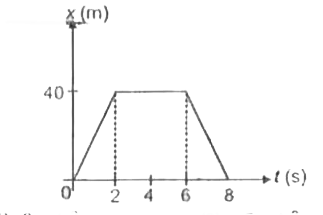A particle executes simple harmonic motion about x=0 along x-axis. The position of the particle at an instant is given by x=(5cm)sinπt. Find the average velocity and average acceleration for a time interval 0−0.5s.
Hint : Average velocity =x2−x1t2−t1
x1=5sin0
x2=5sin(π×0.5)
t2−t1=0.5
Average acceleration =v2−v1t2−t1
v=dxdt=5πcosπt
⇒aav=5πcos(π×0.5)−5πcosθ0.5
To solve the problem, we will calculate the average velocity and average acceleration of a particle executing simple harmonic motion described by the equation x=5sin(πt) over the time interval t=0 to t=0.5 seconds.
Step 1: Calculate the position at t1=0 seconds
Using the position function:
x1=5sin(π⋅0)=5sin(0)=0cm
Step 2: Calculate the position at t2=0.5 seconds
Using the position function:
x2=5sin(π⋅0.5)=5sin(π2)=5⋅1=5cm
Step 3: Calculate the average velocity
The average velocity vavg is given by the formula:
vavg=x2−x1t2−t1
Substituting the values we calculated:
vavg=5cm−0cm0.5s−0s=5cm0.5s=10cm/s
Step 4: Calculate the velocity at t1 and t2
To find the average acceleration, we first need the instantaneous velocities at t1 and t2.
The velocity v is the derivative of the position function:
v=dxdt=5πcos(πt)
Calculating the velocity at t1=0:
v1=5πcos(π⋅0)=5π⋅1=5πcm/s
Calculating the velocity at t2=0.5:
v2=5πcos(π⋅0.5)=5π⋅0=0cm/s
Step 5: Calculate the average acceleration
The average acceleration aavg is given by:
aavg=v2−v1t2−t1
Substituting the values we calculated:
aavg=0cm/s−5πcm/s0.5s−0s=−5πcm/s0.5s=−10πcm/s2
Final Results
- Average Velocity: 10cm/s
- Average Acceleration: −10πcm/s2
Using the position function:
x1=5sin(π⋅0)=5sin(0)=0cm
Using the position function:
x2=5sin(π⋅0.5)=5sin(π2)=5⋅1=5cm
The average velocity vavg is given by the formula:
vavg=x2−x1t2−t1
Substituting the values we calculated:
vavg=5cm−0cm0.5s−0s=5cm0.5s=10cm/s
To find the average acceleration, we first need the instantaneous velocities at t1 and t2.
v=dxdt=5πcos(πt)
v1=5πcos(π⋅0)=5π⋅1=5πcm/s
v2=5πcos(π⋅0.5)=5π⋅0=0cm/s
The average acceleration aavg is given by:
aavg=v2−v1t2−t1
Substituting the values we calculated:
aavg=0cm/s−5πcm/s0.5s−0s=−5πcm/s0.5s=−10πcm/s2
- Average Velocity: 10cm/s
- Average Acceleration: −10πcm/s2
Topper's Solved these Questions
- OSCILLATIONSBOOK - AAKASH INSTITUTECHAPTER - OSCILLATIONSEXERCISE - ASSIGNMENT ( SECTION -A)
58 Videos
- OSCILLATIONSBOOK - AAKASH INSTITUTECHAPTER - OSCILLATIONSEXERCISE - ASSIGNMENT (SECTION-B )
25 Videos
- OSCILLATIONSBOOK - AAKASH INSTITUTECHAPTER - OSCILLATIONSEXERCISE - Assignment (Section D) (ASSERTION-REASON TYPE QUESTIONS)
13 Videos
- NUCLEIBOOK - AAKASH INSTITUTECHAPTER - NUCLEIEXERCISE - ASSIGNMENT (SECTION-D)
10 Videos
- PHYSICAL WORLDBOOK - AAKASH INSTITUTECHAPTER - PHYSICAL WORLDEXERCISE - ASSIGNMENT (Section-B)
5 Videos
Similar Questions
The velocity of a particle is given by v=v0sinωt, where v0 is constant and ω=2π/T. Find the average velocity in time interval t=0to t=T/2.
View SolutionThe displacement x of a particle varies with time as x=4t2–15t+25. Find the position, velocity and acceleration of the particle at t = 0.
View Solution
Knowledge Check
A particle is executing SHM about y =0 along y-axis. Its position at an instant is given by y=(7m)sin(πt). Its average velocity for a time interval 0 to 0.5 s is
A14m/sB7m/sC17m/sD28m/sPosition of a particle at any instant is given by x=3t2+1 , where x is in m and t in sec. Its average velocity in the time interval t=2 sec to t=3 sec will be :
A15m/sB12m/sC18m/sD6m/sA partilce is executive simple harmonic motion given by
x=5sin(4t−π6)
The velocity of the particle when its displacement is 3 units isA2π3 unitsB5π6 unitsC20 unitsD16 units
The velocity of a particle are given by (4t–2) ms–1 along x–axis. Calculate the average acceleration of particle during the time interval from t = 1 to t = 2s.
View SolutionThe position (x) of a particle moving along x - axis veries with time (t) as shown in figure. The average acceleration of particle in time interval t = 0 to t = 8 s is

View SolutionA particle executes simple harmonic motion between x=−Aandx=+A. The time taken for it to go from 0 to A/2. is T1 and to go from A/2 to A is T2. Then:
View SolutionThe position of a particle along X-axis at time t is given by x=2+t−3t2. The displacement and the distance travelled in the interval, t = 0 to t = 1 are respectively
View SolutionThe displacement (in metre) of a particle moving along X-axis is given by x=18t+5t2. The average acceleration during the interval t1=2s and t2=4s is
View Solution
